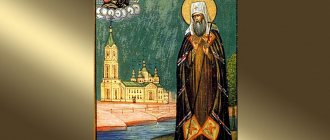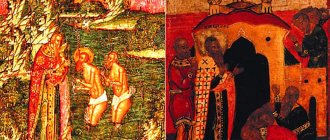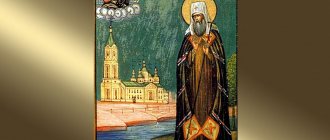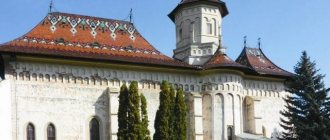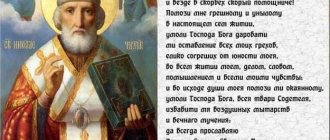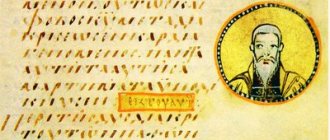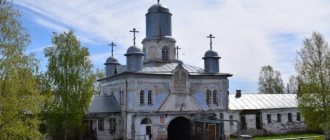VASILY NOVY
St. Vasily is scourged. Miniature from the Life of Vasily the New. 50-60s XVIII century (State Historical Museum. Music No. 196. L. 192 vol.)
St. Vasily is scourged. Miniature from the Life of Vasily the New. 50-60s XVIII century (GIM. Music No. 196. L. 192 vol.) [Greek. Βασίλειος ὁ Νέος] († 944 or 952), St. (mem. March 26). In his youth he lived as a hermit in the border region in Asia. Was received by Byzantine envoys. imp. Leo VI for a spy and brought to K-pol (c. 896). The emperor sent him for interrogation to his close associate Samona, V.N. was tortured, but answered all questions with silence. Thrown into the sea, he was miraculously rescued by dolphins. At first, V.N. settled in the house of a certain John, whom he healed of a fever, and then with the royal courtier (primikirium) Constantine and the Gongili brothers. The rumor about his ascetic life and miracles spread throughout the city, and the sick and those thirsting for spiritual guidance began to flock to him. V.N. had the gift of insight, and many people came to him for advice. nobles and even members of the imp. families. V.N. died at a very old age and was buried in the monastery of Chartophylax, near the monastery of Saints Florus and Laurus. Rus. pilgrim Anthony of Novgorod reports that the relics of the saint are at the end. XII - beginning XIII century were in Chrysopolis, and explains that “it was Saint Basil who wrote about the Last Judgment” (Book of the Pilgrim, p. 38).
The memory of V.N. is noted in some Greek. verse synaxars on November 18. (for example, GIM. Sin. Greek. 354, 1295; Paris. gr. 1578, XV-XVI centuries), but is not included in printed calendars.
The Life of Vasily the New was written by his disciple Gregory, many of whom researchers consider him a layman who had an estate near the Thracian city of Redest (Kazhdan. P. 270), although from the text of his life it rather follows that these lands were owned by Mr. Gregory. In a number of lists of the life of Gregory, Gregory is directly called “an imaginary.” There is also an opinion that, contrary to the manuscript tradition attributing the Life of Basil the New to Gregory, he is not the author of this work (Novakoviћ, p. 42).
The life reflects the events of the social and political life of Byzantium in the 1st half. X century (the uprising of Constantine Duca in 913, the death of Christopher Lekapin, the Hungarian invasion of the Balkans, the attack of the Russian fleet on K-pol in 941).
P. I. Zhavoronkov
Life of Vasily Novy
(BHG, N 263) was created in the 2nd half. X century in K-field; it is known in various editions, of which the greatest value is for fame. traditions have the following: 1) edition, reflected in the list Ath. Dionys. 187, 1328; 2) a lengthy edition, the main representative of which is the manuscript of the State Historical Museum. Syn. Greek 249, XVI century. (these 2 editions form the 1st textual family according to the classification of H. Angelidi); 3) edition represented by the Ath list. Iver. 478, XIII century. (3rd family according to H. Angelidi).
Student of St. Vasily writes his life. Miniature from the Life of Vasily the New. 50-60s XVIII century (GIM. Music No. 196. L. 89 vol.) Pupil of St. Vasily writes his life. Miniature from the Life of Vasily the New. 50-60s XVIII century (GIM. Music. No. 196. L. 89 vol.) In addition to the full text of the life of Byzantium. traditions know abbreviated versions, in particular the revision as part of the Sinait manuscript. gr. 532, XV-XVI centuries, containing only Gregory’s Vision of the Last Judgment, as well as a number of versions containing Theodora’s Walk through the ordeals. An Arab is apparently associated with one of these reworkings. translation of the life, made in Damascus in 1693: “The Life of St. Basil the New and a description of the vision that Theodora, his maid, saw during the separation of her soul from her body.” This translation is preserved in the Damask manuscript. Orth. Patr. 227 (according to other numbering - 1639), 1790
The Life was twice translated into Church Orthodoxy. language. The oldest translation was made, in all likelihood, in the end. XI century in Rus'. Greek the original of this translation belonged to the oldest edition that has not survived, the text of which is closest to the text of the 1st edition presented in the manuscript Ath. Dionys. 187. The 2nd translation of the life was completed no later than the 14th century. at the south Slavs Greek original 2nd glory. translation refers to the edition reflected in the Ath list. Iver. 478, where the hagiographic episodes are shortened, and the main content consists of 2 large visions: Theodora’s Walk through the Tollhouses and the Vision of the Last Judgment.
Despite the fact that the text of the oldest translation of the Life of Basil the New is only known for several years. lists (the oldest of them is the RSL. Egor. No. 162, late 15th century), its distribution in Rus' is evidenced by extracts from it and processing presented in ancient Russian. traditions: for example, the story of PVL about the campaign of the prince. Igor on K-pol (941). A small excerpt from the eschatological part of the oldest translation of the life was included in the Meril of the Righteous (heading: “”) and is already present in its oldest list, 2nd half. XIV century (RSL. Trinity. No. 15. L. 53-55 vol.).
The stories from the life that were included in the Prologue had a special handwritten tradition. A short version is contained in Old Russian. lists of the 1st edition of the unstitched Prologue for March 26. The source of the prologue article was the ancient translation of the Life of Basil the New. In the 2nd edition of the non-verse Prologue, the same life was placed under November 22, and its transfer to another date was not accompanied by editing of the text. Around 30 Dec. in the 2nd edition a short Life of St. Petersburg appears. Theodora of Constantinople, which is missing in the 1st edition of the unstitched Prologue (its text also depends on the ancient translation of the Life of Basil the New).
In Russian The lists of the verse Prologue under March 26 contain a more extensive narrative about V.N. It is based on a brief life of the non-verse Prologue, supplemented by new episodes from the full text of the Life of Vasily the New according to ancient glory. translation. In Yuzhslav. in the editions of the verse Prologue, V.N.’s memory and text are absent, with the exception of a special Serb. edition, in the cut on November 18. Only the memory of the saint is indicated. The appearance of this memory is probably associated with the process of dissemination of the 2nd (South Slav) translation of the Life of Vasily the New, which is known in a large number of lists of both South Slav and Russian. origin (one of the early Russian lists - RGADA. F. 201. No. 16, 1st quarter of the 15th century).
T. N. Pentkovskaya
Life of Vasily the New as lit. The monument combines traditions. a narrative about the life of a saint with apocryphal visions (in which the theme of “small” and “great” eschatology is most fully and vividly presented). Compositionally, the life consists of 2 parts; Part 1 describes the posthumous ordeal of the soul of St. Elder Theodora, who served V.N. When mon. Gregory wanted to know about her afterlife fate, then she, through V.N.’s prayer, appeared to Gregory in a dream and told him about her posthumous fate. The vision is framed by a description of individual episodes from the life of V.N.
The 2nd part of the life tells of the vision of the Last Judgment revealed to Gregory. Seduced by the idea of God's chosenness of the Jewish people, he told his doubts to his spiritual father and heard in response an angry invective against the Jews who did not accept the Son sent by the Father and crucified Him: “They themselves and their Law are rejected from God.” When asked to send him a sign to confirm his faith, Gregory receives a vision that can be compared with the “Revelation of John the Theologian” in terms of the significance of the eschatological themes raised in it and the expression of revealed images of the end of the world.
This part of the life influenced both narrative sources (the story in the PVL about the Greek philosopher and the cuff on which the “Judgment of the Lord” was depicted; numerous appeals to the theme of the Last Judgment in Russian church teaching collections; sermons of St. Abraham Smolensky), and on the iconography of the Last Judgment.
Using the artistic technique of doubling, a mirror image of the main motive - the vision of the afterlife, the author of the life shows that thanks to their righteousness, Gregory and other disciple V.N. - John - get the opportunity to establish themselves in the truth of the Christian doctrine regarding the posthumous fate of man.
Initially, the popularity of the Life of Vasily the New, with its description of the afterlife torment awaiting the unbaptized, was associated with the process of Christianization of Rus' (cf. the story in PVL about the impression made by the cuff with the image of the Last Judgment on Prince Vladimir). It influenced the iconographic program of subsequent compositions of “The Last Judgment”, concretized its pictorial details and scenes, and outlined semantic accents.
The spread of which arose in the 14th century. in Bulgaria, 2nd edition of the life of Yuzhno-Slav. environment, according to I. Tarnanidis, is associated with the influence of the ideas of hesychasm (Tarnanidis. R. 155). In con. XV century the expectation of the end of the world in connection with the expiration of 7000 years from the creation of the world (1492) strengthened the eschatological sentiments of ancient Rus. scribes and, accordingly, interest in the Life of Vasily the New, containing a description of the Last Judgment.
I. V. Dergacheva
From the 2nd half. XVII century The Life of Vasily the New, with its developed and extremely expressive eschatology, takes on a rebirth among the Old Believers in connection with the expectation of the imminent end of the world and the coming of the Antichrist. From the XVII-XIX centuries. Hundreds of copies of the monument have reached us (2nd edition of the translation), including many front ones. The Life was rewritten both as a whole and separately as the visions of Gregory and St. Theodora. They were part of numerous Collections and Flower Books (for example, only in the Museum Collection of the State Historical Museum, which began to take shape in the last quarter of the 19th century, there are a significant number of complete lists alone: No. 17, 28, 31, 36, 48, 74, 142, 144, 155, 172, 173, 179, 258, 317, 320, 345, 350, 354, 362, 370, 373, etc.). From the end XVIII century the life was repeatedly published by Old Believer printing houses (see: Voznesensky, p. 90), surviving until the turn of the 1st and 2nd decades of the 19th century. at least 6 editions: the first was published approx. 1795 in the printing house of F. Kartashev in Klintsy (on the title - Pochaev, 1794).
In con. XVII century based on the oldest translation of the Life of Basil the New St. Demetrius of Rostov compiled an abbreviated version of it and published it in the 3rd volume of “The Book of Lives of Saints” (Kyiv, 1700). The reductions affected mainly the eschatological part of the monument, which is due to the extreme popularity of these particular subjects among the Old Believers. The edition of Demetrius of Rostov served as a source for the revision of the Life of Basil the New, made by Sophrony, bishop. Vrachansky (c. 1805).
From 2nd quarter XVII century personal copies of the complete text of the Life of Basil the New (usually in the form of a separate book), as well as the visions of Gregory and St., became widespread (mainly in the Old Believer environment). Theodora (as part of collections). The number of miniatures in them amounts to tens and sometimes exceeds a hundred: for example, the State Historical Museum. Muzeysk. No. 48 (40s of the 17th century) contains 162 miniatures; No. 345 (70s of the 17th century) - 164; No. 317 (last quarter of the 17th century) - 75; RSL. F. 178. M. 4110 (last quarter of the 17th century) - 134; State Historical Museum. Muzeysk. No. 188 (mid-18th century, vision of Gregory) - 49; No. 37 (same, 50-60s of the 18th century) - 154; No. 142 (70s of the 18th century) - 168; No. 36 (70-80s of the 18th century) - 181, etc.). Since the 18th century individual plots and compositions illustrating the life are becoming widespread in Old Believer lubok (wall sheets), both handwritten and printed. The iconography of cycles of miniatures for the hagiography and individual plots remains practically unstudied.
Source: BHG, N 263-264f; PG. 109. Col. 653-664; Veselovsky A. N. Investigations in the Russian region. spiritual verse // Collection. 1889. T. 46. P. 117-145; 1891. T. 53, No. 6. P. 185-213; JSV. March. pp. 501-552; Novakovic B. St. Belly of St. Vasilija Novog: Apocryphal legend about the belly from the land of the grave according to the Srpso-Slovenian manuscripts // Spomenik. Beograd, 1895. T. 29; Vilinsky S. G. Life of St. Vasily Novy in Russian. literature. Od., 1913. Part 1: Research; 1911. Part 2: Texts; Tarnanidis IC The Slavonic Manuscripts Discovered in 1975 at St. Catherine's Monastery on Mount Sinai. Thessal., 1988. P. 148-156; Dergacheva I. V. Posthumous fate and “another world” in ancient Russia. bookishness. M., 2004. pp. 205-326.
Lit.: Sakharov V. Eschatological op. and legends in ancient Russian. writing and their influence on the people. spiritual poems. Tula, 1879. P. 166-192; Pesenti G. Un rifacimento greco-volgare della vita di san Basilio scritta da Gregorio asceta // BZ. 1929/1930. Bd. 30. P. 316-323; Grégoire H., Orgels P. L'invasion hongroise dans la “Vie de S. Vasile le Jeune” // Byz. 1954. T. 24. P. 147-156; Costa-Louillet da G. Saints de Constantinople // Ibid. P. 492-511; Nasrallah J. Histoire du mouvement littéraire dans l'église melchite du Ve au XXe siècle. Louvain, 1979. P. 211; ᾿Αγγελίδη Χ. ῾Ο Βίος τοῦ ὁσίου Βασιλείου τοῦ Νέου. ᾿Ιωάννινα, 1980; Ryden R. The Life of St. Basil the Younger and the Date of the Life of St. Andreas Salos // Okeanos: Essays Presented to I. Ševčenko on his 60th Birthday. Camb., 1984. P. 568-577; Tvorogov O.V. Life of Vasily the New // SKKDR. 1987. Vol. 1. pp. 142-143; Kazhdan A. Basil the Younger // ODB. Vol. 1. P. 270-271; Ivanov S. A. Byzantine foolishness. M., 1994. S. 85-86, 137, 186; Goldfrank DM Who Put the Snake on the Icon and the Tollbooths on the Snake?: A Problem of Last Judgment Iconography // HUS. 1995. Vol. 19. P. 180-199; Voznesensky A.V. Old Believer publications XVIII - early. XIX century St. Petersburg, 1996; Mikhailycheva (Pentkovskaya) T.V. Lexical data of the Life of Vasily the New: (On the problem of localization of the oldest Slavic translation) // Tr. young scientists: Linguistics. M., 1998. P. 129-154; Samir Kh. La version arabe melkite du roman d'Alexandre du Pseudo-Callisthène // ByzF. 1999. Bd. 25. S. 61; Vilinbahova T. L'immagine della morte nell'arte della Russia antica // Humana Fragilitas: I temi della morte in Europa tra Duecento e Settecento / A cura di A. Tenenti. Clusone, 2000. P. 259-260; Buslaev F.I. Image of the Last Judgment // aka. Old Russian Literature and Orthodoxy art. St. Petersburg, 2001. pp. 191-193; Viktorov V.V. Serb. list of the Life of Vasily Novy con. XIV - beginning XV (?) century from the collection of P. I. Sevastyanov in the Russian State Library // Rumyantsev Readings, 2003. M., 2003. P. 32-35; Pentkovskaya T.V. Extracts from the life of Vasily the New as part of the Prologue // DRVM. 2003. No. 4 (14). pp. 53-54; she is the same. The most ancient glory. translation of the Life of Vasily the New and his Greek. original // VV. 2004. T. 63 (88). (in the press).
A. A. Turilov
Iconography
St. Vasily talks with John and Elena. Miniature from the Life of Vasily the New. 50-60s XVIII century (GIM. Music No. 196. L. 99 vol.)
St. Vasily talks with John and Elena. Miniature from the Life of Vasily the New. 50-60s XVIII century (GIM. Music No. 196. L. 99 vol.) In Greek cargo. manuscript, in a medallion (RNB. OI 58. L. 47 vol., 15th century), the main image of V.N. (or St. Basil the Decapolite (?), commemorated February 28) is presented in a brown robe, with simple hair , gray hair, curly at the ends, falling to the shoulders, a beard of medium length, wedge-shaped.
In "Erminia" by Dionysius Furnoagrafiot, beginning. XVIII century, about the appearance of V.N. it is said: “With gray in his curly beard” (Part 3. § 13. No. 47).
The life of the saint was uniquely reflected in the lengthy description of his appearance in the Filimonovsky consolidated icon-painting original (XVIII century): “the likeness of an old man, his face pale and dry from great fasting, his hair terkhava and gray-haired, brada like Vlasiev, shorter and a little terkhovaty, one robe, his feet are bare, next to him a lion beast is written... in a strange and terrible way, as if he was raised in the desert, feeding on water, walking barefoot and wearing the worst rags.” “Guide to the writing of icons of the holy saints of God” (1910), compiled by V. D. Fartusov, suggests depicting a charter with his sayings in the hand of a saint.
In Russian In the menain cycles, the image of the saint is practically not found, since his memory falls on the celebration of the Council of Arch. Gabriel, to whom preference is given in the image.
Lit.: Erminia DF. P. 172; Filimonov. Iconographic original. P. 303; Fartusov. Guide to painting icons. P. 228; Mijoviě. Menologist. pp. 297, 313, 338; Evseeva. Athos book. P. 200.
E. V. Shevchenko
Content
The Life combines the story of the saint’s life with apocryphal visions that clearly express the theme of “small” and “great” eschatology.
Consists of parts:
- The first part describes the posthumous ordeal of the soul of the Venerable Elder Theodora, who served Vasily. After the death of Theodora, Vasily’s student Gregory wanted to know about her afterlife and often asked the ascetic to reveal this to him. Through Vasily’s prayers, Gregory saw Theodora in a dream. The old woman told him about her death, about the struggle for her soul between angels and demons, about how her soul went through ordeals (trials of sinfulness), about the heaven and hellish torments she saw, and how Vasily’s prayers helped her. The description of the vision is framed by a description of individual episodes from the life of St. Basil.
- The second part of the life tells of the vision of the Last Judgment, which was also revealed to Gregory. The student was seduced by the idea of God's chosenness of the Jewish people, he told Vasily about his doubts and heard in response an angry invective against the Jews, who did not accept God the Son, sent by God the Father, and crucified Him: “They themselves and their Law are rejected from God.” Gregory asks to send him a sign to confirm his faith and receives a vision. In terms of the significance of the eschatological themes raised in it and the expression of the revealed images of the end of the world, this vision is comparable to the Revelation of John the Theologian. This eschatological part gives reason to consider the Life as an apocryphal monument.
Using the technique of doubling, a mirror reflection of the main motive, the vision of the afterlife, the Life shows that thanks to their righteousness, Gregory and another disciple of Basil, John, have the opportunity to verify the truth of the Christian teaching about posthumous fate and establish themselves in the true faith.
The Life reflected the events of the social and political life of Byzantium in the first half of the 10th century: the uprising of Constantine Ducas in 913, the death of Emperor Christopher Lecapinus, the Hungarian invasion of the Balkans, the attack of the Russian fleet on Constantinople in 941 (part of the Russian-Byzantine War of 941-944 ).
In the Old Believers
The Life of Vasily the New, which has a developed and expressive eschatology, gained great popularity from the second half of the 17th century among Old Believers, who expected the imminent end of the world and the coming of the Antichrist.
In the 17th–19th centuries, hundreds of copies of the second edition of the translation were created, including a large number of recitals. The Life was rewritten both as a whole and separately - the visions of Gregory and Theodora. They were part of numerous Collections and Flower Gardens.
From the second quarter of the 17th century, mainly among the Old Believers, personal copies of the complete text of the Life of Basil the New, as a rule, in the form of a separate book, as well as the visions of Gregory and Theodora as part of collections, became widespread. They include dozens and sometimes more than hundreds of miniatures.
Since the 18th century, individual plots and compositions illustrating the Life have become widespread in handwritten and printed Old Believer lubok (wall sheets).
Since the end of the 18th century, the Life was repeatedly published by Old Believer printing houses. Before the turn of the first and second decades of the 19th century, at least 6 editions were published. The first was published around 1795 in the printing house of F. Kartashev in Klintsy, the title says: Pochaev, 1794.
